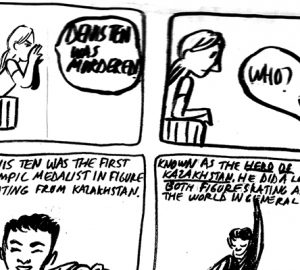There’s more to Olympic skaters’ costumes than spandex and sparkles
By Mackenzie Lachey

Figure skating is one of the most popular Winter Olympics sports to watch in America. With the perfect combination of athleticism and glitz, it’s no wonder the sport captures the hearts of millions of Americans every four years. Maybe you tune in to see your favorite skater land a perfect triple lutz and know the difference between a twizzle, salchow and camel. Or maybe you simply enjoy the show — the music, the drama, and of course, the costumes. There’s no shame in that, because nothing is quite like it.
Caroline Ruder, a graduate fashion student, said she loves watching figure skating for both the skill and the costumes. “I really appreciate the coordination it takes, because I can hardly stand up in ice skates,” she said. “But of course I [also] love it for the costumes.”
While other Olympic athletes wear warm, functional uniforms, figure skaters flaunt figure-exposing ensembles decked out in an impressive array of sequins and spandex crucial to their overall score. Outlandish they may be, but that is part of the appeal. “These outfits that would be super tacky in any other context in life are pretty much the most fabulous part of the Olympics,” according to Ruder. “I love the glitter and sparkle.”
But there is more to skating costumes than sparkles and skin-toned mesh. The outfits can be the margin between a victory and loss, and not just in terms of style points (yes, that is a real thing).
On Feb. 13, Mirai Nagasu made history by being the first American woman to land a triple axel during the Olympics. And as she became famous overnight, so did her flame-red dress. There is a lot to consider when designing a figure skating costume like the one Nagasu wore. The outfit is most often inspired by the routine and counts towards the skater’s creative presentation, along with the music, the routine’s composition and interpretation. But of course, the skating and proper execution of jumps and spins is of utmost importance. The designer of Nagasu’s now-famous red dress, Pat Pearsall, designed it specifically for the execution of that momentous jump.
Nagasu couldn’t have anything weighing her down, so her dress was noticeably less bedazzled than many of her glitzy counterparts. Every rhinestone adds up, so Pearsall showed sparkle restraint by only incorporating around 2,000 crystals, a modest amount compared to the standard figure skating dress which can contain 5,000 or more. Nagasu’s simple dress was inspired by Halle Berry’s body-hugging scarlet gown in the Bond movie “Die Another Day.”
Ruder thought the costume was a great choice for Nagasu and added to the excitement of her accomplishment. “It’s super cool to watch someone do something that’s never been done before,” she said. “I think the punchy red compliments the strength of her routine.”
Nagasu, like many skaters, opted for a shorter skirt. The length of the skirt can affect the execution of spins and jumps. A longer skirt adds weight that can pull or whip around as the skater spins in the air.
Skaters don’t have to wear skirts, but this is a relatively new rule. Up until 2006, it was against the rules for female skaters to wear unitards or trousers. Ice dancers, however, are still required to wear skirts or dresses.
The material must also be considered. Skaters’ outfits, including Nagasu’s dress, are mostly made of stretch fabrics like Lycra that are lightweight and durable. A well-engineered ensemble supports the athlete in her execution rather than cause a dazzling disaster by making moves more difficult or even creating a wardrobe malfunction.
There are also rules to consider. The International Skating Union mandates that the skaters’ costumes be “modest, dignified and appropriate.” The judges look to see that 50 percent of a skater’s upper body is covered, which may immediately bring to mind the back-baring, sultry dress worn by Canadian skater Tessa Virtue during her ice dance with partner Scott Moir. The couple’s routine was altered for the Olympics because one of their lifts was considered too racy. Virtue’s steamy dress had many wondering how she remained fully clothed during the sensual number performed to the “Roxanne” tango from “Moulin Rouge.”
For some, the dress was a standout and a perfect complement to a beautiful number. Ruder thought the deep red color and cut of the dress gave the whole routine an edge, balancing out the elegant routine.
Although skating costumes haven’t changed much in the past few decades — the preferred look has been, for quite some time, short, stretchy dresses that sparkle with embellishments — it wasn’t always that way. In the 1920s and ’30s, skaters wore outfits that looked much like something they would wear on the street. But the rise of synthetic fibers and stretch fabrics began to change that. By the ’60s, costumes were beginning to resemble what we are accustomed to seeing today — close-fitting dresses with circle skirts. The fabrics gradually allowed women to look more athletic and became more elaborate and eye-catching. Today, we are seeing more revealing costumes, especially for women, with the addition of flesh-colored mesh that allows the illusion of cutouts or strapless designs without risking wardrobe malfunctions. Although The International Skating Union has taken the stance that costumes “must not give the effect of excessive nudity,” it is clear some costumes push the envelope.
To see some of the highlight skating costumes from the 2018 Winter Olympics, click here.



























